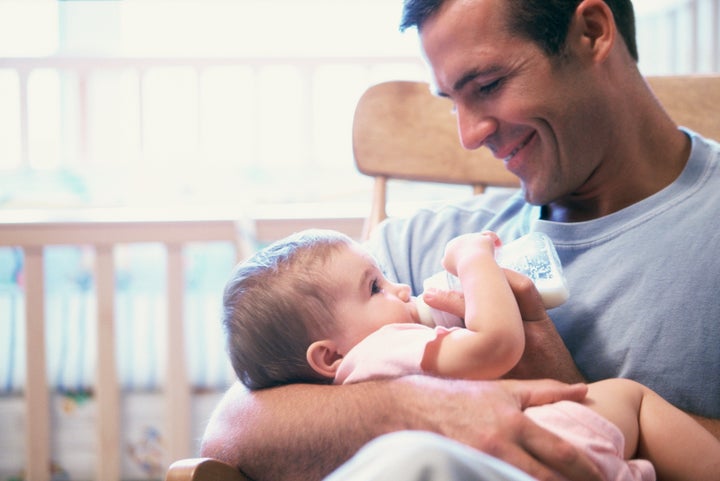
“Please help a tired mama out. My six-month-old wakes up crying every 45 minutes overnight. He’s never slept longer than a couple of hours unless I hold him. He wants boob constantly. I’m so exhausted that I can’t function. Should I sleep train? Pls, no judgment. Pic of my son passed out on my nipple in comments.”
Nothing divides a Facebook parenting group comment section like sleep training.
Some parents swear by it, convinced it saved their sanity and their marriages in that exhausting and overwhelming first year with a baby. Others are abhorrently against it, convinced it’s cruel not to respond to a baby’s needs for comfort overnight.
Somewhere in between are the tired-as-hell parents who’ve tried everything to get their baby to sleep and just want to know more about sleep training so they can make their own decision about what’s best for their family.
WATCH: The truth about sleep training. Story continues below.
Zombie parents, we got you. Here’s everything we know.
Sleep training isn’t necessarily the right choice for everyone, Elisa Costanza, a holistic infant and child sleep consultant and early childhood educator based in Ottawa, told HuffPost Canada.
If something is working for you — whether it’s co-sleeping, or nursing your baby to sleep and then transferring them to the crib — then there’s no need to change that, she added.
“When it’s not working for you and you’re not surviving anymore, that’s when you make the change,” said Costanza.
“You don’t need to be chronically sleep-deprived just because you’re a parent.”
What is sleep training?
Sleep training is an umbrella term for the various methods of teaching your baby that they can fall asleep on their own (ie. without being rocked, bounced, fed, or otherwise soothed to sleep) and put themselves back to sleep when they wake up in the night.
Most methods involve putting your baby on a schedule and following a bedtime routine, with the eventual goal of putting your baby to bed and leaving them there as they drift off to sleep.
Schedule and routine are the cornerstones of a good sleep, Costanza said, noting that if a baby doesn’t go to bed at the right time, they won’t sleep well. And they rely on a sequence of pre-bed events (such as a bath, stories, and lullabies) as cues that it’s bedtime.
“We want to make sure their brain is getting the memo that it’s time to go to sleep.”

What are the methods?
There are all kinds of different approaches to sleep training. Some of the more popular include:
Extinction, or cry-it-out: doing your night routine, then putting the baby to bed, walking away, and not coming back until it’s time to get up.
Pro: Easy, usually quick
Con: So. Much. Crying. Not for the faint of heart.
Check-ins or graduated extinction (or the Ferber method): doing your night routine, putting the baby to bed, leaving the room, and checking in at pre-set, gradually increasing intervals to console them until they fall asleep. Some versions involve picking the baby back up, while others involve a pat on the back or consoling words such as “I love you. Night night!”
Pro: Gentler. Some soothing.
Con: Can take longer to work. Checking in on the baby might just make them more upset.
Sit and stay, or the chair method: doing your night routine, putting the baby to bed, and sitting in a chair in their room, soothing them verbally until they fall asleep. Gradually, over several nights, you move the chair closer to the door until eventually you just leave the room after putting them down.
Pro: You’re with them for emotional support.
Con: You’re watching them cry. They’re watching you watching them cry.
No-cry: slowly and gently working on the foundations for healthy sleep— schedule and routine— then slowly weaning the baby off of sleep props (like being rocked or fed). The no-cry methods will usually have you introducing new ideas one at a time, so as to not overwhelm the baby. For instance, if a baby is used to being nursed to sleep, after you slowly introduce a bedtime and night routine, you would start slowly decreasing the amount of time you nurse before bed each night until it gets to the point that they no longer need to nurse to fall asleep.
Pro: No cry!
Con: Takes forever.
WATCH: Sleep training isn’t perfect, but it’s necessary. Story continues below.
Why is it so controversial?
The crying part. People often think sleep training is JUST the cry-it-out method, and even the cry-it-out method isn’t always fully understood.
Regardless, almost all sleep training involves some crying, which doesn’t sit well with a lot of parents. And that’s OK! Some people prefer more of an attachment parenting style, which is when you provide your baby with a nurturing, consistent, and immediate response to their needs (ie., going to that baby when it cries in the night).
Some worry it will damage their bond with their baby.
People also worry sleep training is selfish, based on a parents’ own need for a good rest. Some people believe baby sleep is misunderstood (they aren’t meant to sleep like adults), and aren’t capable of self soothing.
Is it actually harmful?
Science says no.
In 2012, the American Academy of Pediatrics put out a statement that infant sleep training is “effective and safe.” This was based on a study that followed 225 kids from infancy to age six. Those who were sleep trained using graduated extinction and bedtime fading methods at age seven months showed no differences in their mental health, stress levels or maternal-child relationship compared to a control group.

Another 2016 study found that letting babies cry themselves to sleep doesn’t lead to emotional, behavioural or parent-child attachment issues.
It is worth nothing that both these studies involved babies around the six-month mark.
Getting a good sleep is important to a child’s health and wellbeing, and those who don’t may have trouble functioning during the day, CPS notes on its website.
But if the parents are inconsistent with their sleep training, that can make it drag on, which isn’t ideal, Costanza said.
As well, there is a difference between crying themselves to sleep, and crying because they have a dirty diaper, or are sick, or are genuinely hungry, so it’s important to make sure your child’s needs are met before you let them cry. Use your judgment.
Does it work?
Yes, according to a comprehensive 2018 review published in the Canadian Family Physician journal.
“Sleep training improves infant sleep problems, with about one in four to one in 10 benefiting compared with no sleep training, with no adverse effects reported after five years,” the review noted.
Maternal mood also significantly increased in those that sleep trained.
That doesn’t mean it will work right away, and not every method is suitable for every baby or parent.
As Canadian family doctor Stephanie Liu wrote in The Conversation about her own experience: “The process was incredibly stressful and upsetting. Ultimately, we had to try three different methods before we found one that worked for us. In the end, unmodified extinction worked.”
When can you start sleep training?
Usually between four and six months, Costanza said.
You don’t want to do it in the newborn phase, when they don’t yet have the ability to self soothe and haven’t quire mastered the concept of day vs. night, but you can start implementing some methods early on, like establishing a bed-time routine, to encourage them.
As well, most experts recommend sleeping in the same room as your baby for at least six months (and even up to a year) to help cut the risk of Sudden Infant Death Syndrome.
Can you still feed your baby at night if you’re sleep training?
Yes! It’s a common misconception that sleep training means you have to night wean, Costanza said.
You can still do one or two feeds, unless the baby is showing signs they can sleep through the night without one, she added.

What’s the big deal with feeding or rocking your baby to sleep, anyway?
Nothing, if it works for you. But if that baby starts waking up after 10 minutes and can only go back to sleep with another feed/cuddle/bounce, now it’s an issue.
Adults wake up throughout the night all the time— to change positions, adjust a blanket, check the time, etc. The key is that we can fall back asleep. But for babies who are fed or rocked to sleep, they may need that same pattern EVERY SINGLE TIME they wake up, Costanza said.
“If it’s interrupting their sleep, that’s when it becomes a challenge.”
So, should I try sleep training, or what?
That is entirely up to you and what works for your family!
But whether you decide to cry it out, sit and stay, co-sleep, room share, sleep on your kid’s floor, or stay up rocking your baby hoping the sleeplessness is just a phase, we hope you can get some Zzzs soon.
Also on HuffPost: